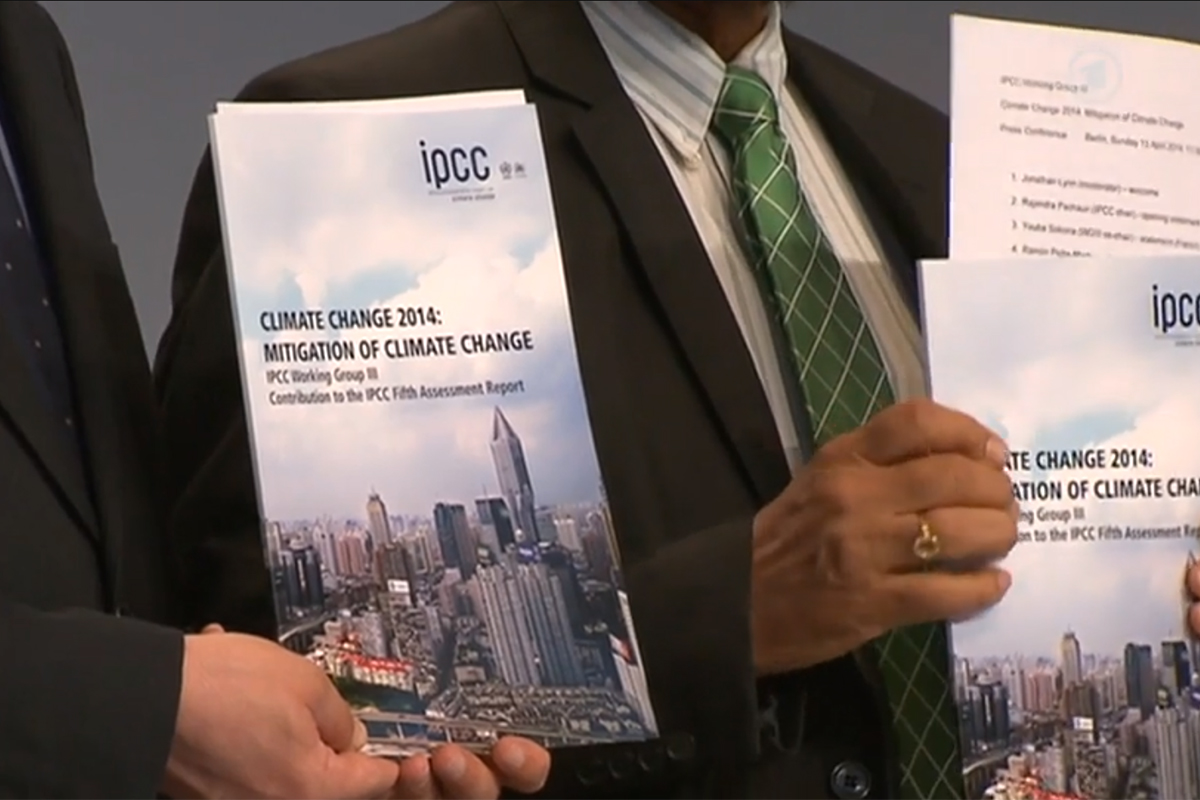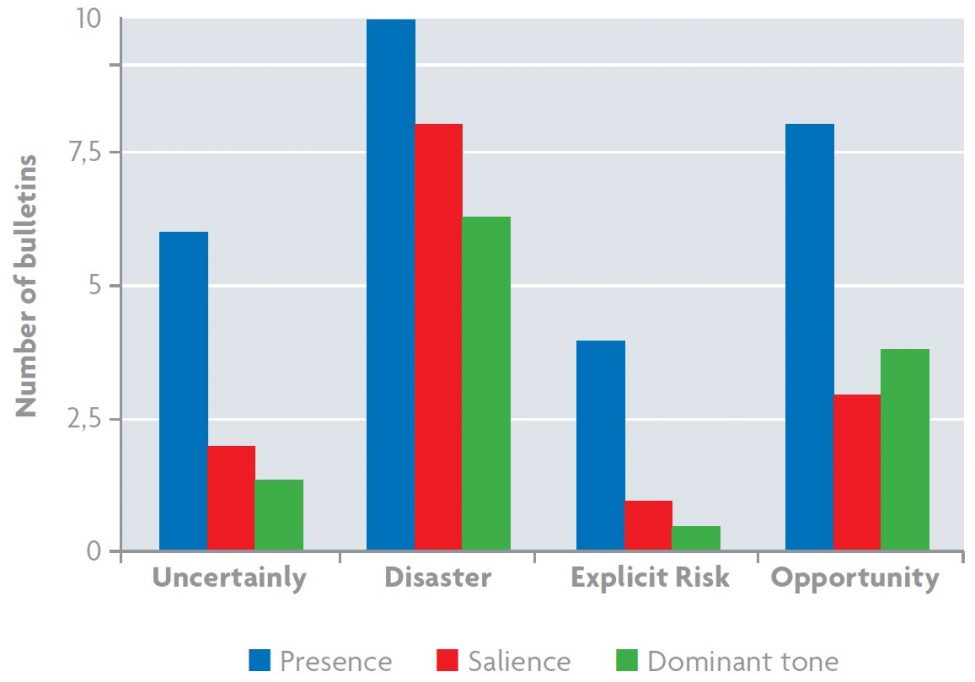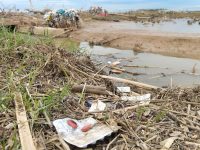Disaster, uncertainty, opportunity or risk?
Key messages from the television coverage of the IPCC’s 2013/2014 reports

This article examines the television coverage of the three 2013 and 2014 reports by the Working Groups of the IPCC in five European countries: Germany, Norway, Poland, Spain and the United Kingdom. The presence, salience and dominance of four frames (disaster, uncertainty, explicit risk and opportunity) were examined in each of the bulletins monitored. The «disaster» frame was the strongest of all the frames, measured by all three metrics. «Opportunity» was the next most present, followed by «uncertainty». Although the IPCC put considerable emphasis on a risk management approach to tackling climate change in its communication of the WG2 report, the «explicit risk» frame was hardly present. The UK stood out for including some coverage of sceptical viewpoints.
Keywords: climate change, media coverage, IPCC reports, Europe.
European Union countries and Norway have set more ambitious targets for curbing greenhouse gas emissions than most developed economies. Collectively, the public in EU countries show sustained higher levels of concern about climate change than in other industrialised countries. For example, between 2008 and 2013, the proportion of those surveyed who thought climate change was a «very serious» or «fairly serious» problem remained constant at 90%. In contrast, over the same period in the USA, the proportion of American people who were «somewhat» or «very worried» about global warming fell from 63% to 53% (Painter, 2014, p. 17).
«The public in EU countries show sustained higher levels of concern about climate change than in other industrialised countries»
However, the figures for the EU mask important country differences. The UK often scores more highly than other countries for those who do not think climate change is a problem. This may be linked to the strong presence of sceptical lobby groups such as the Global Warming Policy Foundation in the UK, and its success in getting a sceptical message across in the media, particularly in right-leaning tabloids (Painter, 2011, pp. 91–110). Poland too has a more pronounced tendency towards scepticism than other EU countries, perhaps linked to its reliance on coal (Kundzewicz & Matczak, 2012).
The notable presence of scepticism in these two countries is just one of the differences between the five countries included in this study (Germany, Norway, Poland, Spain and the UK), which are amongst those chosen as a focus for a research project under the EU’s Joint Programming Initiative (JPI) on Climate. The five countries offer a range of different media landscapes, journalistic practice, and political and social contexts in which climate change receives coverage.
Scientists from all five countries contribute to the Working Group (WG) reports by the Intergovernmental Panel on Climate Change (IPCC). These are published every five to six years and together constitute the most authoritative international summary of what is known about the science of climate change. The reports have an extensive impact on the interaction of science and policy (Adler & Hadorn, 2014).
The Working Group reports are divided into three, namely WG1: The physical science basis, WG2: Impacts, adaptation and vulnerability and WG3: Mitigation of climate change (IPCC, 2014). The media have paid them considerable attention. For example, the publication of the Fourth Assessment Report in February to May 2007 contributed to a noticeable spike in the amount of coverage on climate change by the print media in several parts of the world, and particularly Europe and North America.
There is a wealth of material now available on the televisual treatment of environmental issues (Anderson, 2014; Cottle, 1993). León and Erviti (2015) have looked at the specific issue of climate change coverage on Spanish television, but a focus on televised coverage is not common (Schäfer & Schlichting, 2014, p. 155). There is very little research on the television reporting of the IPCC reports. This is an important omission. Despite the revolution in the way audiences, and particularly young people, now get their information, in most countries television is still the most used and trusted source of information for news – including news about science.
For example, in the UK television remains the most important and frequently used mode of news consumption by some margin, compared to newspapers, radio, or new media, and it is also the most important source for news about science (Painter, 2014, p. 62). In 2014, 68% of the British people regularly used television news and programmes as the main source of science information. This compares to 23% for print, and 15% for online newspapers and news sites, and 2% for blogs.
It is a similar picture in three of the other four countries included in our study. In a 2014 survey of ten countries, Germany emerged as the country with the lowest level of online news access (along with France), but showed a strong allegiance to traditional news platforms (Newman & Levy, 2014, p. 44). Television was mentioned as the main news platform by 56%, compared to online (19%), radio (13%) and print (11%). On the specific issue of climate change, Germans use television as their main source of information and trust it more than other media (Schäfer & Schlichting, 2014).
The Newman and Levy study (2014) showed that nearly half of Spanish people use television as their main source of news. However, in sharp contrast to Germany, over a third prefer online (including social media), followed by print (11%) and radio (4%). In a recent poll in Poland, television held the dominant position as an information source about climate change (over 90%), followed by the Internet, daily newspapers, the radio, and weekly publications (which were all mentioned by about one third of the interviewees) (Kundzewicz & Matczak, 2012).
Norway is an exception to this trend. In a recent survey, 66% of those asked (over 15 years old) either agreed or agreed a little that the Internet was their main news source, followed by 57% for TV, 46% for radio, 36% for newspapers and 33% for mobile (Medienorge, 2014).
Framing climate change
The media scholar Robert Entman provides a useful analysis of framing as it pertains to selection and salience, which are of particular relevance here. He writes that to frame is to «select some aspects of a perceived reality and make them more salient in a communicating text, in such a way as to promote a particular problem definition, causal interpretation, moral evaluation, and/or treatment recommendation for the item described» (Entman, 1993).
It is clear from the literature that the three frames of «disaster/catastrophe», «uncertainty» and «opportunity» are common ways in which the media regularly presents the climate change «mega-story» (Painter, 2013). For example, the «disaster» frame, which places a strong emphasis on the adverse impacts or «crisis» elements of the climate change story, such as Arctic ice melt, more drought or more extreme weather events, was shown to be the most common frame in an analysis of climate change coverage by the UK quality press from 1997 to 2007 (Doulton & Brown, 2009). The «uncertainty» frame has been analysed from several angles including the various ways it can be represented in texts (Corbet & Dufee, 2004; Zehr, 2000), and as an indicator of «controversial science» where sceptics are mentioned (Antilla, 2005).
These and other frames have been subject to considerable scrutiny by communication scholars as to their efficacy in promoting public understanding, engagement, or behaviour change (Painter, 2014). The disaster narratives prevalent in the media are often not regarded as helpful to sustained personal engagement. Emphasising more hopeful messages, such as the opportunities of low carbon development, is seen by some scholars as more helpful for engagement from some sectors than a narrative of catastrophe or disaster.
«Climate change frames have been subject to considerable scrutiny by communication scholars as to their efficacy in promoting public understanding, engagement, or behaviour change»
Scientific uncertainty is often misunderstood, particularly by the general public, and misinterpreted as ignorance. It can be an obstacle to decision-making. This has fed into an active debate as to whether, in some cases, framing climate change as one of «risk» is more helpful. The four frames of «disaster», «uncertainty», «opportunity» and «explicit risk» are particularly apposite for an assessment of the coverage of the 2013 and 2014 Working Group reports. The many uncertainties surrounding climate change included ranges of projections, the presence of sceptical voices or duelling experts, and/or the inclusion of words like «may», or «possible». The news agency Reuters found that in the 30-page Summary for Policy Makers (SPM), which highlighted the main points of the 2,000-page WG1 report on the physical science of climate change, the word «uncertain» appeared 41 times, compared to the 26 mentions in the 18-page 2007 SPM (Doyle, 2013).
Of particular relevance to the «uncertainty» frame was the presence or absence of discussion about the climate «pause», which refers to the lack of significant rise in global average temperatures since 1998. Sceptics were accused of pushing the story of the «pause» as part of a concerted campaign to undermine the case for action (Ward, 2014).
One of the key messages of the WG3 report was that it would be possible, using an array of technological measures, low-carbon energy and changes in behaviour, to limit the increase in global mean temperature to two degrees Celsius. For example, the report stressed the opportunities presented by and benefits of low-carbon transport, such as more safety for citizens, better health and greater energy security.
Finally, in the press release and communication efforts around the second report (WG2), the IPCC went to considerable lengths to portray the climate change challenge as one of «risk management». The co-chair of WG2, Chris Field, spoke repeatedly about the need, in the face of uncertainty, to weigh up the risks of possible outcomes.
Research method
Our main focus was an assessment of the relative presence or absence of the four dominant frames mentioned above. The research method involved a priori frame definition and an essentially quantitative approach towards content analysis. It concentrated on what elements of certain frames were present in each story, and their relative weighting, in order to get some insight into what messages about climate change viewers might be receiving when they watch and hear these bulletins. Three metrics were used to assess the four frames – presence, salience and dominant tone. Presence is measured by the appearance of the frames anywhere in an article and salience by their presence in headlines or the opening element of the report. Dominance includes a wide variety of indicators such as the relative weight of a frame throughout an article, salience, prominent quotes, and the use of language such as metaphors and adjectives.
A popular news bulletin on a highly trusted television channel was chosen in each of the five countries. These were Germany: ARD Tagesschau at 20:00; Norway: NRK Dagsrevyen at 19:00; Poland: TVP1 Wiadomości at 19:30; Spain: TVE Telediario at 21:00; UK: BBC News at Ten at 22:00.
The five channels have a combined estimated audience of around 15 million. The news bulletins selected were one of the most trusted and watched in each country. It is interesting to note that the audience for each bulletin far exceeds the circulation (but not necessarily the reach) of the largest newspaper in the five countries. So for example, BBC News at Ten has an average audience of 4-5 million compared to the 2 million of the largest circulation tabloid newspaper (The Sun) or the 500,000 of the largest broadsheet (The Telegraph). In Germany, ARD Tagesschau’s audience of 4.5 million compares to the 2 million of Bild; NRK Dagsrevyen’s 700,000 to Aftenposten’s 320,000; and TVE Telediario’s 2 million to the 320,000 of El País. Poland’s Wiadomości is watched by 3.5 million; Fakt is the Polish tabloid with the largest newspaper circulation of about 430,000.
«“Opportunity” was the next most present, salient and dominant frame. It was strongly dominant in the coverage of WG3, which focuses on solutions»
We examined one evening bulletin on one channel in each country the day before and the day of the release of the three IPCC WG reports, which came out in September 2013, March 2014, and April 2014 respectively. This gave us a total of 30 bulletins, of which nearly half (14) carried items on the IPCC reports. The volume of coverage was pretty consistent across four of the five countries. The channels in Norway and the UK ran four reports, Germany and Spain three. However, Poland’s TVP1 carried none.
The selection of two bulletins on consecutive nights on only one channel per country means that our results are not as robust as would have been the case if more bulletins had been included in the sample over a longer period. This is particularly true of the BBC, which ran a number of preview pieces before WG1, WG2 and WG3.
«Television news needs pictures to tell stories, and is better at telling stories than dealing with issues»
Results
As can be seen in Figure 1, across all three IPCC reports taken together, the «disaster» frame was the strongest of all the frames, measured by all three metrics. As was to be expected, this was particularly true of WG2, which focuses on impacts, but it was also strongly present in the reporting of WG1 (on the physical science). Perhaps surprisingly, «opportunity» was the next most present, salient and dominant. It was strongly dominant in the coverage of WG3, which focuses on solutions, but it was also present in the reporting of WG1 and WG2.

Figure 1. Presence, salience, and dominant tone by theme in television coverage about the IPCC Working Groups reports in 2013 and 2014. / Source: James Painter
«Uncertainty» was present in six of the fourteen news bulletins, and especially in the coverage of WG1, but it was not particularly salient or dominant. It was salient in two, and a dominant tone in just one. The «explicit risk» frame was the least present, and was a dominant tone the least number of times (once – when it was shared with another frame). It was only salient in one of the reports. The frame would have been more present if the journalists had included the IPCC language of likelihood and confidence levels, which is a way of assessing probabilities or risk. Only one bulletin gave a full explanation of what the concepts meant.
Only one of the four channels covering the IPCC reports mentioned the climate «pause» in WG1 (the BBC in the UK). Only one sceptic appeared on screen (Professor Richard Tol, again on the BBC).
«The IPCC reports were full of the adverse impacts from runaway greenhouse gas emissions, which make for compelling news particularly when it can be illustrated by striking images»
Discussion
It is perhaps not surprising that «disaster» should be more common than the other frames or narratives the study surveyed. The IPCC reports were full of the adverse impacts from runaway greenhouse gas emissions, which make for compelling news particularly when it can be illustrated by striking images. Journalists continue to be attracted to such dramatization of the climate change story.
It is interesting to note that «uncertainty» was present in a considerably lower percentage of the 2013 and 2014 news bulletins (43%) than in the print articles examined in a study of the 2007 IPCC reports (87%) (Painter, 2013, p. 68). The «increasing certainty» narrative about the human drivers of increased global temperatures since the 1950s received a considerable amount of media attention and went some way to provide a strong counter-narrative to all the uncertainties. This made «uncertainty» much less likely to be a salient frame or a dominant tone, even though it was relatively strongly present.
The greater presence of sceptics and sceptic discourse in the UK compared to other European countries is consistent with other studies. Research on the media in France (Brossard, Shanahan, & McComas, 2004), Germany (Engels, Hüther, Schäfer, & Held, 2013), and Holland (Dirikx & Gelders, 2009) strongly suggests that the media in these countries exhibit less uncertainty about climate science. Other studies have shown important differences between a wide variety of English-speaking Anglosphere countries (such as Australia, UK, and the USA) and non-Anglosphere countries (Brazil, China, France, Germany, India and Norway) (Painter & Ashe, 2012).
However, more examination is needed of the drivers of these differences in terms of factors within media organisations – journalistic norms such as balance, editorial culture (opinion versus objectivity in reporting), influence of proprietors, newspaper ideology – or within wider society (lobbying groups, sceptical politicians, sceptical readers, sceptical scientists, direct experience of a changing climate, or national cultural/political values or traditions), or some combination of the two. It is surprising that the risk narrative was seldom present. Part of the explanation is that television news needs pictures to tell stories, and is better at telling stories than dealing with issues. The «disaster» frame lends itself to a strong narrative, whereas «risk» is more of an issue than a story. Moreover, «risk management» is a difficult concept for journalists to simplify and explain.
This may change. Outside of television news, the risks surrounding climate change are an ever-bigger focus. The Risky Business report in June 2014, for example, used a risk management perspective to lay out the threats from climate change for agriculture, energy, and coastal real estate in the United States. This was followed in September by the Better Climate, Better Economy report from the Global Commission on the Economy and Climate, which also made extensive use of risk language and concepts.
The Financial Times certainly sees the climate challenge in this way. In its editorial on 22 September 2014, it wrote that «climate change, like a financial crisis or an industrial accident, is a high-impact risk with an uncertain probability, and as in those cases it would be negligent not to take precautions to prevent it».
References
Adler, C. E., & Hadorn, G. H. (2014). The IPCC and treatment of uncertainties: topics and sources of dissensus. WIREs Climate Change, 5, 663–676. doi: 10.1002/wcc.297
Anderson, A. (2014). Media, environment and the network society. Houndmills: Palgrave Macmillan. Antilla, L. (2005). Climate of scepticism: US newspaper coverage of the science of climate change. Global Environmental Change, 15, 338–352. doi: 10.1016/j.gloenvcha.2005.08.003
Brossard, D., Shanahan J., & McComas, K. (2004). Are issue-cycles culturally constructed? A comparison of French and American coverage of global climate change. Mass Communication and Society, 7, 359–377. doi: 10.1207/s15327825mcs0703_6
Corbett, J., & Durfee, J. (2004). Testing public (un)certainty of science: Media representations of global warming. Science Communication, 26, 129–151. doi: 10.1177/1075547004270234
Cottle, S. (1993). Mediating the environment: Modalities of TV news. In A. Hansen (Ed.), The mass media and environmental issues. Leicester: Leicester University Press.
Dirikx, A., & Gelders, D. (2009). Global warming through the same lens: An explorative framing study in Dutch and French newspapers. In T. Boyce, & J. Lewis (Eds.). Climate change and the media. New York: Peter Lang.
Doulton, H., & Brown, K. (2009). Ten years to prevent catastrophe? Discourses of climate change and international development in the UK press. Global Environmental Change, 19, 191–202. doi: 10.1016/j.gloenvcha.2008.10.004
Doyle, A. (2013, September 18). Amid “uncertainty”, scientists blame mankind for global warming. Reuters.
Engels, A., Hüther, O., Schäfer, M., & Held, H. (2013). Public climate-change scepticism, energy preferences and political participation. Global Enviromental Change, 23(5), 1018–1027. doi: 10.1016/j.gloenvcha.2013.05.008
Entman, R. M. (1993). Framing: Toward clarification of a fractured paradigm. Journal of Communication, 43(4), 51–58. doi: 10.1111/j.1460-2466.1993.tb01304.x
IPCC. (2014). Intergovernmental panel on climate change: Fifth assessment report (AR5). Geneva: IPCC.
Kundzewicz, Z. W., & Matczak, P. (2012). Climate change regional review: Poland. WIREs Climate Change, 3: 297–311. doi: 10.1002/wcc.175
León, B., & Erviti, M. C. (2015). Science in pictures: Visual representation of climate change in Spain’s television news. Public Understanding of Science, 24(2), 183–199. doi: 10.1177/0963662513500196
Medienorge. (2014). Main news sources. Bergen: Medienorge. Retrieved from http://medienorge.uib.no/statistikk/aspekt/tilgang-og-bruk/374
Newman, N., & Levy, D. A. L. (2014). Reuters Institute digital news report 2014. Oxford: Reuters Institute for the Study of Journalism (RISJ).
Painter, J. (2011). Poles apart: The international reporting of climate scepticism. Oxford: Reuters Institute for the Study of Journalism (RISJ).
Painter, J. (2013). Climate change in the media: Reporting risk and uncertainty. Oxford: IB Tauris & RISJ.
Painter, J. (2014). Disaster averted? Television coverage of the 2013/14 IPCC’s climate change reports. Oxford: Reuters Institute for the Study of Journalism (RISJ).
Painter, J., & Ashe, T. (2012). Cross-national comparison of the presence of climate scepticism in the print media in six countries, 2007–2010. Environmental Research Letters, 7(4): 1–8. doi: 10.1088/1748-9326/7/4/044005
Schäfer, M., & Schlichting, I. (2014). Media representations of climate change: A meta-analysis of the research field. Environmental Communication, 8(2): 142–160. doi: 10.1080/17524032.2014.914050
Ward, R. E. T. (2014). In the public’s mind. Nature Climate Change, 4, 170. doi: 10.1038/nclimate2152
Zehr, S. (2000). Public representations of scientific uncertainty about global climate change. Public Understanding of Science, 9, 85–103. doi: 10.1088/0963-6625/9/2/301





